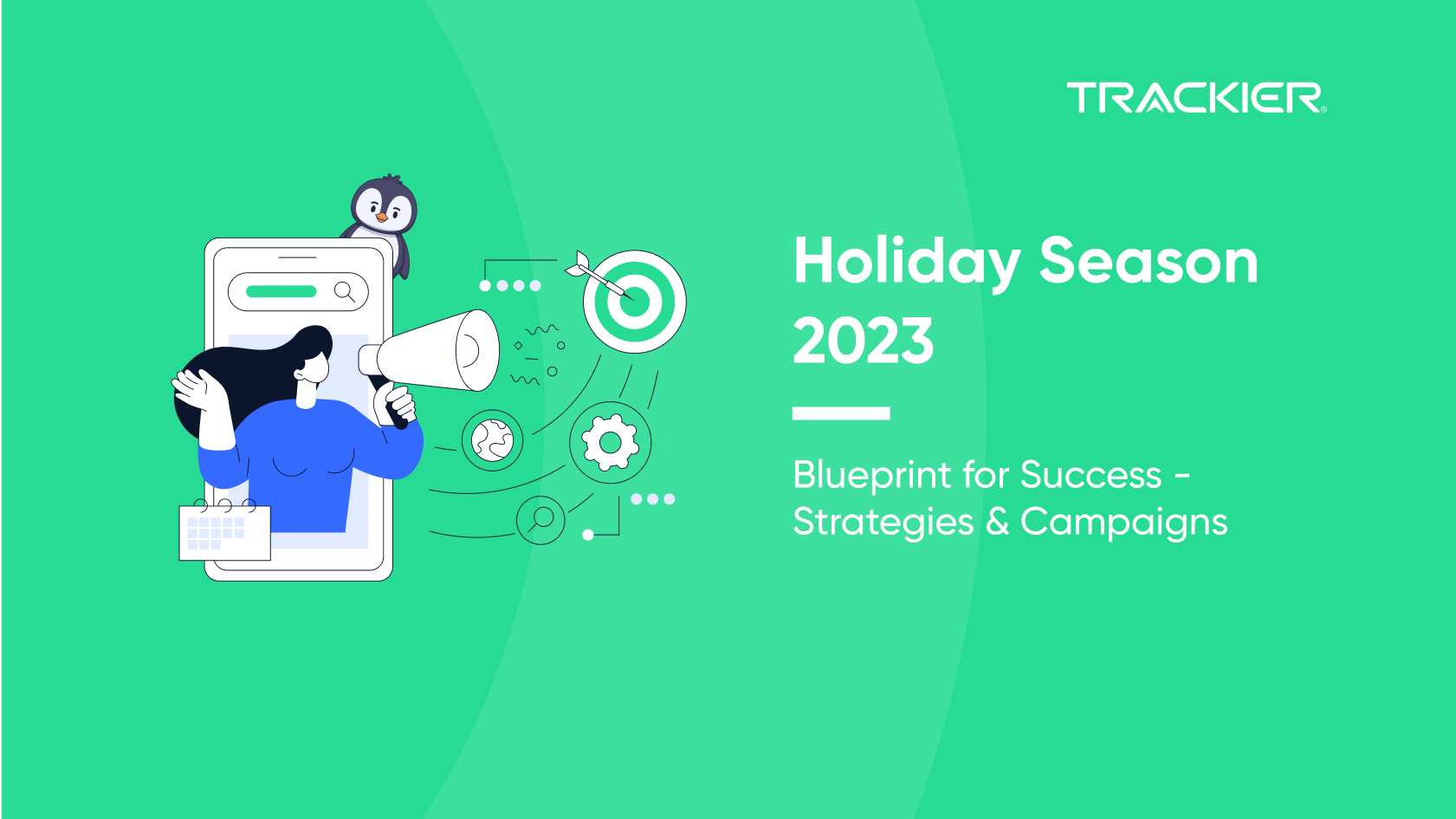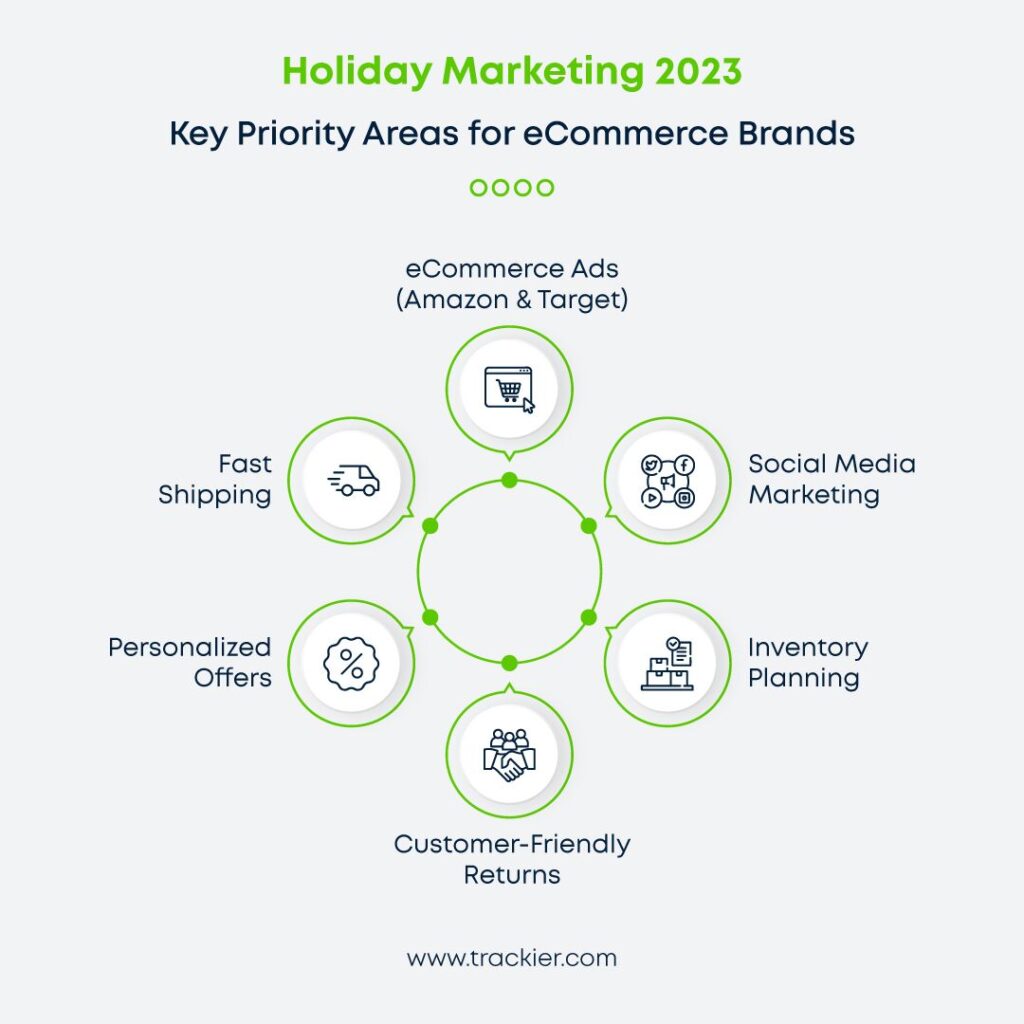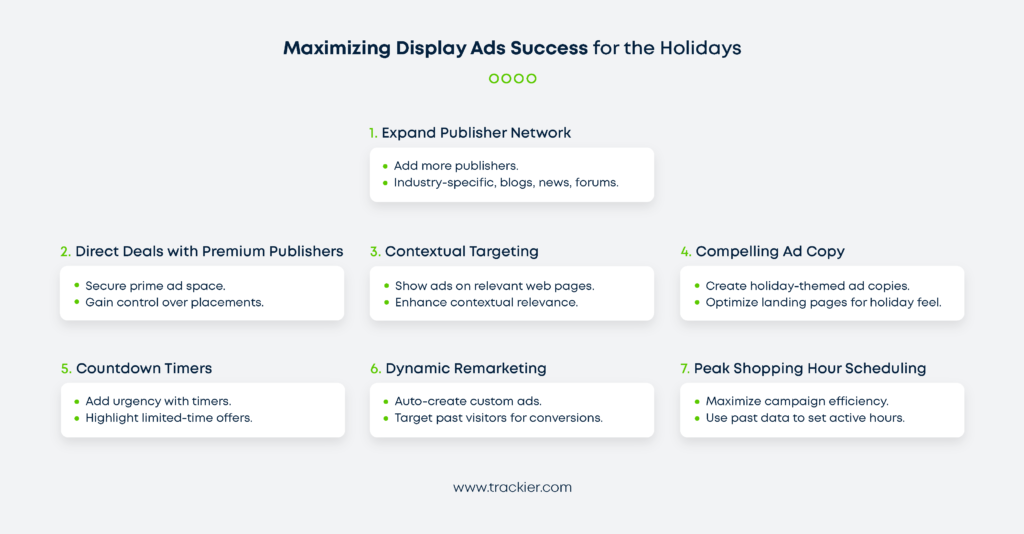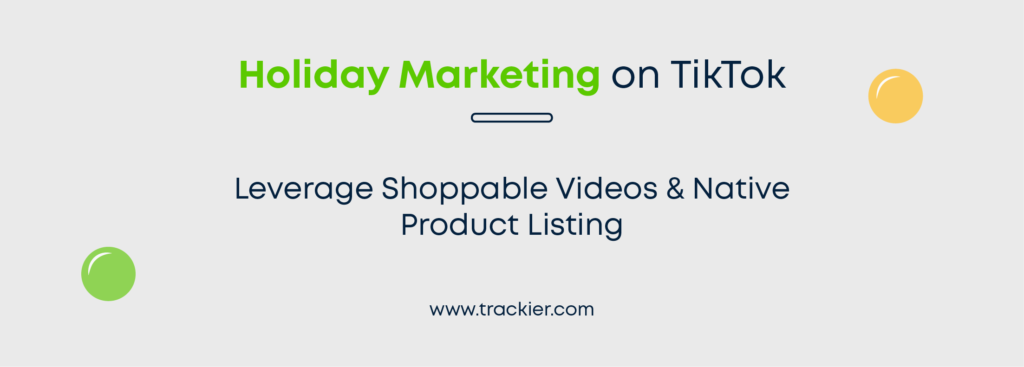It’s going to be THAT time of the year again – the great holiday season that makes every eCommerce brand go Ka-ching! Starting with Halloween in October, going all the way to New Year’s Eve, this quarter is brimming with opportunities – to up your sales, boost customer retention, or even capture new markets. Let’s explore Holiday Marketing strategies for 2023 in this blog post.
Before we jump into the 2023 Holiday Marketing guide, let’s give you a quick overview of 2022’s eCommerce success. In 2022, holiday season retail sales grew by 4.8% YoY, with consumers spending $211.7 billion online in online shopping! But that was before the mass layoff season of 2022 kicked off in December. While tidal layoffs settled down in the H1 of 2023, the lingering sentiments are expected to continue, potentially influencing holiday season shopping trends.
If we go by predictions and analysis, this year is going to be crucial for eCommerce brands. Price-conscious consumers are expected to keep a tight grip on their expenses influenced by the macroeconomic conditions. However, on the bright side, brands can still cash in on the Holiday season by putting value and affordability at the forefront of their marketing campaigns. The one-size-fits-all approach will no longer be valid this year.
With higher stakes and more conscious customers, eCommerce brands will have to think out of the box and walk even greater distances to meet their customers’ expectations this year.
It’s not going to be easy, but if done right, it can get you the coveted rewards of increased sales, profit margins, customer loyalty, and a joyful holiday season filled with success.
Holiday Marketing Trends 2023: Unveiling Customer Sentiments
Before getting right into sketching strategies, let’s take a step back and look into the past data to understand the customer sentiments and determine key priority areas for the holiday season 2023.
- 30% of shoppers start their holiday shopping as early as October and some even before, which means your holiday campaigns should be up and running by the end of September.
- Going by historical data, holiday purchases are highly influenced (in order of decreasing priority) by Price, Sales, Free Shipping, Fast Shipping, and Easy Returns.
- 72% of customers in 2022 spent less than $200 on their holiday gifting and essentials, which implies that retailers can make big on low-ticket products to make a larger number of sales.
- 56% of Gen Z shoppers are influenced by TikTok while 38% of Boomers are by Facebook – Depending upon your target audience, invest more in the platform that is relevant to your business.
- 62% of shoppers plan to buy mostly online, which offers a huge opportunity for retail business owners to make good business via their own online stores and giants like Amazon and Target.
- Paid search contributed to the major chunks of sales for retailers followed by direct web visits, organic search, and affiliate partners.
- 75% of survey respondents said they will do at least some of their holiday shopping through their smartphone.
- 86% of shoppers will do holiday shopping on Amazon, 60% on Walmart and 47% on Target.
- High cost and late deliveries were the major frustrations of the customers in the 2022 holiday season.
- 69% of shoppers would like to have more personalized offers in addition to good offers, and prices.
- Customers will not prefer to shop from online retailers that lack fast delivery, cost-effective deals, customer-friendly returns, and good customer service.
So now we know what customers really expect from the retailers this holiday season. So let’s reverse engineer this data to define the priority areas for your eCommerce business.
Key Priority Areas for Holiday eCommerce Marketing
- Personalized Offers – No one-size-fits-all approach. Personalize offers for each audience group. Segment your audience on the basis of purchase frequency, monetary value, and preferences.
- Social Media Marketing – Invest in the social media platform your target audience hangs out on. For Gen Z – Instagram & TikTok and for Boomers – Facebook.
- Plan & Manage Inventory – Plan and stock your inventory as per demand prediction. Avoid last-minute order cancellations and delays.
- Customer-Friendly Return Policy – If possible, implement a no-questions-asked return policy for customers throughout the holiday season.
- Fast Shipping – Streamline your logistics and partner with reliable carriers for on-time arrivals.
- Paid Marketing on eCommerce Sites – Amazon & Target – Allocate some budget to eCommerce sites like Amazon and Target to put up your sponsored listing on their websites.
Paid Advertising
Paid advertising is one of the tried and tested methods to boost sales during the holiday season. In fact, 25% of marketers allocate their marketing budget toward paid social media ads, with 20% of businesses putting their bets on display ads and 14% of search ads.
While you might have already been investing in paid ads, the strategy that works all year round might not work here or it might yield only ‘meh’ results. So let’s find out how you can plan your paid ads strategy for each type of format to cash in on the holiday season Hoo-ha.
Paid Search
Run PPC campaigns on the leading search engines – Google and Bing. To chalk out a killer strategy for the holiday season 2023, here are some pointers you need to keep a mental note of.
- Start with your last year’s campaigns: What audiences performed better? What headlines converted better? Use last year’s data to analyze how you performed against your competitors. What worked for them? Is there any improvement in your offerings since the last year? Create one set of a campaign based on historical data.
- Use seasonal keywords: Use seasonal keywords for your Black Friday, Cyber Monday, Christmas, Thanksgiving, etc. campaigns to get sales and clicks. Include keywords like ‘perfect Christmas gifts for family’, ‘Thanksgiving presents’, etc. in addition to the standard keywords you follow.
- Don’t ignore Quality Score: Strive to achieve ‘Good’ or ‘Excellent’ quality score on your Responsive Search Ad Campaigns. Create strong headlines and descriptions without repetition that can form good, high-converting combinations.
- Use Ad Extensions: It is an additional component that can improve your overall customer experience. Add location, specific landing pages, reviews or ratings, etc. to the ad listing.
- Leverage your existing customers list: Upload your list (Customer Match) on Google Ads and remarket to your existing customers for the holiday sales. You can also target a similar audience to get your ads in front of an audience that is more likely to buy from you.
- Start your campaign early: Let’s say you’re running a Black Friday Sale campaign, run it at least 2 weeks earlier. This gives it ample learning time and good results even before the sale kicks off.
- Don’t set and forget: Running a PPC campaign is nothing like cooking a turkey – just put it in and wait for the heat to do its magic. Analyze your campaigns on a daily basis. If it’s working, pump more money into it (if there’s room for it). If it’s not working, analyze keywords, update your negative keywords, or try a new bid strategy. You can also use Seasonality Adjustments to inform Google’s Smart Bidding of the expected changes in conversions.
Display Ads
Leverage Google Display Network to expand your reach and engage with a broader audience during the holiday season. Here are some key points to consider.
- Expand your publisher network: Add more publishers to your network to expand your reach, traffic, and ultimately, conversions. Consider industry-specific websites, popular blogs, news outlets, and even niche forums or communities related to your products or services.
- Direct deals with premium publishers: For premium publishers or high-impact placements, consider negotiating direct deals. This allows you to secure prime ad space on specific websites, giving you more control over your display ad strategy.
- Use contextual targeting: Utilize contextual targeting options provided by the Google Display Network. This allows your ads to be shown on web pages that contain content related to your products or services. It ensures that your ads are contextually relevant, increasing the chances of engagement.
- Warm and holiday-like ad copies: Messaging matters. The ad copies must be relevant to your target audience to make them click in the first place. Similarly, optimize your landing page for the holiday season to get the conversion chart kicking.
- Leverage countdown timers: Use countdown timers in your ads to create a sense of urgency, indicating limited-time holiday sales or promotions.
- Dynamic remarketing: This feature of Google’s Display Network helps you automatically create customized ads for people who’ve visited your product pages in the past but didn’t complete their purchase.
- Schedule ads for peak shopping hours: Avoid wasting your budget on inactive hours. Set your campaigns for peak shopping hours on the basis of your previous campaign data.
Social Media Ads
If your target audience comprises mainly millennials and GenZ, social media is something you can’t afford to ignore, more so during the holiday season. Already investing in social media ads? It’s time to amp up the strategy!
- Plan video asset creation well in advance: When’s the right time? The answer is now. Start populating your video assets for the holiday season already. Emphasize the ‘why’ of your brand. Why do you do what you do? Why they should buy from you instead of your competitors?
- Use seasonal creatives: Your ad creatives should smell ‘Holiday’ through and through. If possible, optimize your social media profiles for the Holiday season as well.
- Retarget premium customers: Run a separate campaign on repeat customers and high-value buyers with personalized offers to drive sales.
- Segment your audience: Segment your audience data into 3 groups: VIP customers, cart abandoners, and newcomers.
- Make use of Meta Commerce Suite: Reduce the friction for buyers by integrating Meta Checkout for your Facebook eCommerce.
Amazon & Target Ads
As we’ve mentioned earlier – the majority of holiday shoppers are going to buy from eCommerce giants like Amazon and Target. Therefore, you can’t afford to put up a sponsored listing there, can you? Here’s how to go about it.
- Sponsored video ads: Create educational or demonstrative videos of your products for a sponsored listing on Amazon. Keep the video well within 30 seconds with on-screen text that is easily readable on mobile devices.
- Incorporate audio ads on Amazon: Amazon audio ads are a great way to interact with connected audio users during the holiday season. Keep your audio clear, straightforward, and more offer-focused to grab listeners’ attention and drive them toward completing the purchase.
- Leverage FireTV & Twitch ads: Generate incremental reach by creative placements on Amazon Fire TV and Twitch. Make sure that your creatives have clear messaging and CTA about your offer and deal.
- Target product ads: Explore different formats including Native CPC on the Target website as well as mobile apps to target loyal Target customers using targeting based on first-party data.
TikTok In-Steam Shop for Holiday Marketing
Just in – TikTok has recently launched an in-stream shop, which includes shoppable ads, and native product listing for eCommerce brands in the US. The timing couldn’t be any better – just before the holiday season kicks off. There’s a good amount of time for US-based retailers to plan a strategy to capitalize on this newest push by TikTok.
Looking to craft your holiday marketing action plan on TikTok In-Stream Shops? Let us break it down for you.
What’s New with TikTok In-Stream Ads?
Earlier, this feature was available only to select US retailers. On September 12, 2023, the social media giant launched it for all US retailers. The current In-Stream TikTok Ads support shoppable videos, Live shopping, and product listing on its app, which means eCommerce brands can now list their products on TikTok in a product showcase on their profiles and run shoppable ads that include a secure payment through a third-party payment gateway.
TikTok Creative Challenge Affiliate Program
If you’re looking to grow your sales during the holiday season via affiliate marketing, TikTok has a solution. The social media platform has its own Creative Challenge Affiliate Program that helps affiliates and brands collaborate for mutual success.
Just like Amazon Fulfilled, TikTok also runs a ‘Fulfilled by TikTok’ program through which retailers can submit their top-selling products for which the platform will manage orders including the shipping, delivery, and returns/exchanges.
How are TikTok In-Stream Ads and In-App Shopping Beneficial for eCommerce Brands?
- In-stream ads offer direct checkout from TikTok app itself which implies less friction between the browsing and shopping process. This seamless customer experience leads to better and swifter conversions.
- It reduces the time between the first interaction of a potential customer with a brand and the sale, giving the brand a competitive advantage since they are able to capture the customer before their competitors.
TikTok Shoppable Ads: How to Get Started
If you haven’t started yet, you still have time to decide on your TikTok Shoppable Ads for expanding your sales channel for this holiday season. However, there’s a catch. TikTok is advisable only for brands whose target audience is GenZ and millennials. If your target audience lies outside these age groups, you might want to reconsider investing in TikTok ads.
- Planning on Product Catalog: As we’ve mentioned previously in the blog post, consumers are less likely to spend more than $200 on holiday shopping. But this doesn’t mean an end for eCommerce brands. It offers an opportunity to cash on small-ticket products in your inventory. Therefore, prioritize listing affordable yet chic products in your catalog alongside the big-ticket products. Make sure you list the products that contribute a good amount to your overall sales.
- Set up conversion tracking: If you’re using a SaaS platform to track conversion, set up your conversion tracking well before the sales begin. If you’re using Trackier’s Performance Marketing Software, you can contact your dedicated CSM for support.
- Build out assets: Create highly engaging holiday-themed video assets that answer your target audience’s concerns. Make sure that you capture the user’s attention in the first 3 seconds of the video – that’s what makes or breaks the deal. Reverse engineer the customers’ pain points to tell your brand’s story.
- Leverage TikTok influencer’s reach: Sign up for TikTok’s Affiliate Program and use influencers’ trustworthiness and reach to get more customers this holiday season. Set up custom payout models for each group of affiliates depending on ther revenue they generate.
Retargeting on Audience Cohorts
While traditional retargeting casts a wide net by targeting all previous website visitors, audience cohorts take this strategy to the next level. Cohorts are groups of users who share specific characteristics or behaviors, allowing for highly targeted and personalized marketing campaigns.
- Audience segmentation: Divide your audience into segments or cohorts based on behavior, demographics, and preferences.
- Retarget existing and interested customers: Retarget customers who have abandoned their cart or didn’t complete the purchase. Run personalized campaigns for loyal and repeat customers.
- Conversion tracking: Implement robust conversion tracking to measure the success of your campaigns accurately. This data will help you determine which cohorts are responding most positively to your efforts.
- Offer additional offers: Don’t be shy to walk the extra mile to convert a high-value customer or for a high-ticket order. Offer extra discounts or freebies to push the customer towards purchase.
Affiliate Marketing & Influencer Marketing
According to a Marketing Dive report, 75% of customers purchased a product in the last year based on an influencer’s recommendation. Therefore, your affiliate campaigns should better be relevant.
- Design holiday-themed coupons: Attract customer’s attention using holiday-specific coupon and discounts.
- Go mobile: Invest in mobile campaigns. Keep your mobile interface user-friendly and friction-free. Reduce unnecessary steps to make the path leading to conversion clutter-free.
- Customize campaigns on different product types: Create campaigns for top-selling products and run them on custom audiences based on demographics and interests. Customize media channels based on their browsing habits.
- Create custom offers for winning affiliates/partners: Create custom coupon codes and commission models for affiliates that bring more business.
- Take multiple Geos and cultures into account: Different countries observe the holiday season differently. For example, in the US, people exchange gifts on Christmas Eve while in Japan, it is done on December 31st. Similarly, Hanukkah is celebrated among Jews all across the globe on December 15. Segment your audience accordingly and target the campaign based on the festival they celebrate.
- Identify the most trending gift options: Get more aggressive on campaigns for products trending among gift options in 2023 for the holiday season.
Also Keep in Mind
- Make sure your website loads well within 3 seconds.
- Make use of Google Analytics to create audiences for this time of year.
- Create holiday themes for the website for the holiday season.
- Check your website for mobile responsiveness.
- Reduce friction between the product page and checkout page. Make the cart checkout seamless and hassle-free.
- Highlight the products that are holiday-themed.
- Make sure your inventory is ready for the peak holiday season orders.
- Prepare holiday-themed boxing and packaging.
- Expand sales channels beyond your regular ones.
- Ramp up your customer service.
In a Nutshell
The holiday season accounts for 30% of sales for a business. So make sure you put your best foot forward and drive maximum revenue out of this peak shopping season.
- Go all out in promoting your holiday special discounts and offers.
- Invest in paid media along with organic efforts.
- Communicate clearly about your shipping and return policies on your website, emails, and social media channels.
- Last but most importantly, Gen Z loves authenticity and straightforwardness. So make sure your offers are genuine and relevant.







